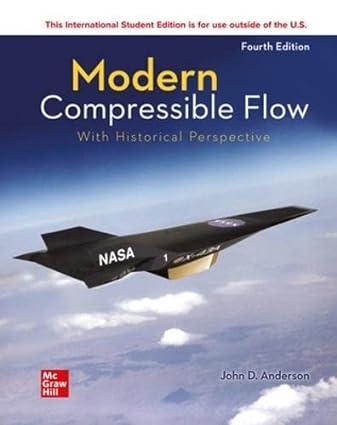The result from problem 5.21 shows that the reservoir temperature for a Mach 20 helium tunnel can
Question:
The result from problem 5.21 shows that the reservoir temperature for a Mach 20 helium tunnel can be very reasonable. This is why several very high Mach number helium hypersonic wind tunnels exist. For the helium wind tunnel in problem 5.21, calculate the nozzle exit-to-throat area ratio. Compare this with the exit-to-throat area ratio required for an air Mach 20 tunnel.
Data From Problem 5.21:
The reservoir temperature calculated in problem 5.20 is beyond the capabilities of heaters in the reservoir of continuous-flow wind tunnels using air. This is why you do not see a Mach 20 continuous-flow tunnel using air. On the other hand, consider the flow of helium, which has a liquefaction temperature of \(2.2 \mathrm{~K}\) at the low pressures in the test section. This temperature is much lower than that of air. For a Mach 20 wind tunnel using helium, calculate the minimum reservoir temperature required to avoid liquefaction in the test section. For helium, the ratio of specific heats is 1.67.
Data From Problem 5.20:
As problems 5.18 and 5.19 reflect, the air temperature in the test section of conventional hypersonic wind tunnels is low. In reality, air liquefies at a temperature of about \(50 \mathrm{~K}\) (depending in part on the local pressure as well). In the practical operation of a hypersonic wind tunnel, liquefaction of the test stream gas should be avoided; when liquefaction occurs, the test stream is a two-phase flow, and the test data is compromised. For a Mach 20 tunnel using air, calculate the minimum reservoir temperature required to avoid liquefaction in the test section.
Data From Problem 5.19:
Consider a hypersonic wind tunnel with a reservoir temperature of \(3000 \mathrm{~K}\) in air. Calculate the theoretical maximum velocity obtainable in the test section. Compare this result with the results of problem 5.18 (a) and (b).
Data From Problem 5.18:
Consider two hypersonic wind tunnels with the same reservoir temperature of \(3000 \mathrm{~K}\) in air.
(a) One tunnel has a test-section Mach number of 10. Calculate the flow velocity in the test section.
(b) The other tunnel has a test-section Mach number of 20. Calculate the flow velocity in the test section.
Step by Step Answer:






